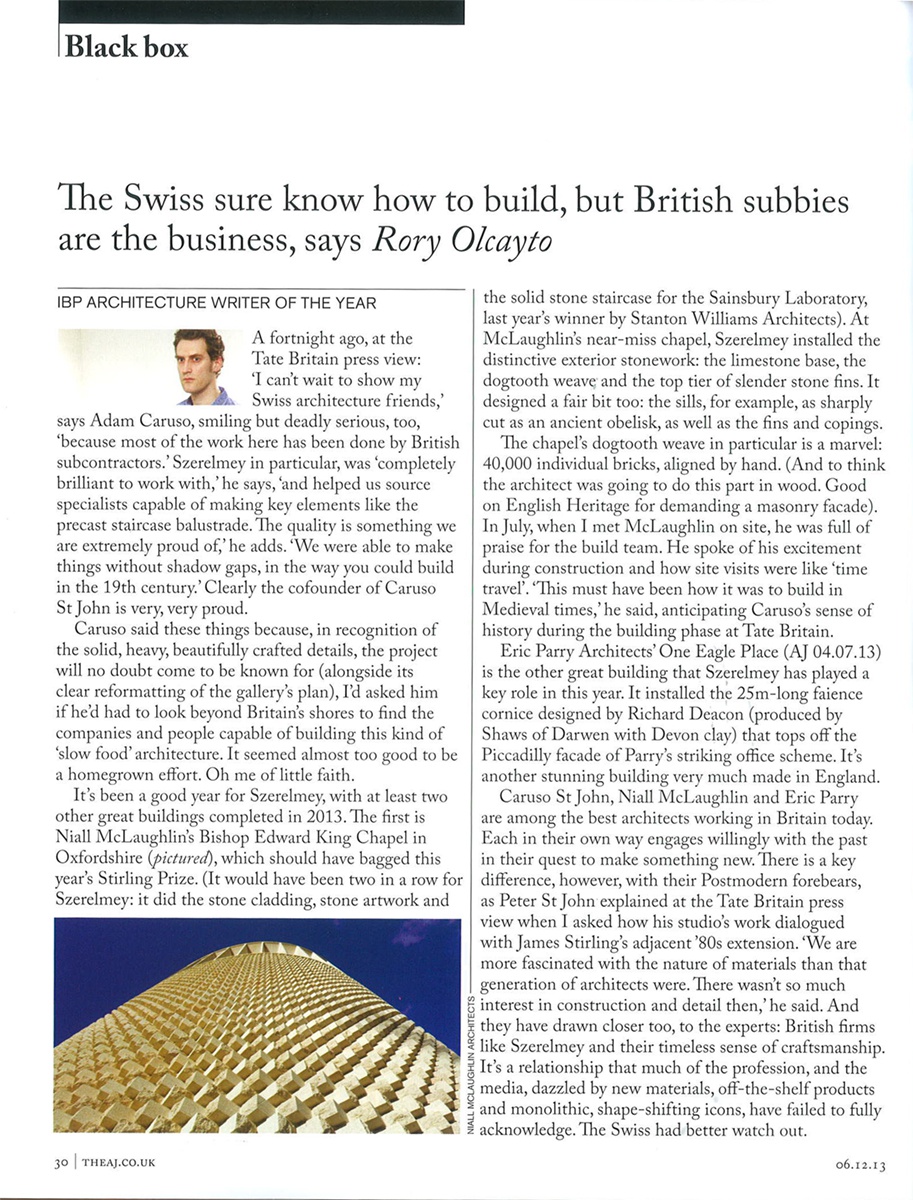Black Box - Architects’ Journal
December 2013
Text Rory Olcayto
Images Níall McLaughlin Architects
The Swiss sure know how to build, but British subbies are the business.
A fortnight ago, at the Tate Britain press view: ‘I can’t wait to show my Swiss architecture friends,’ says Adam Caruso, smiling but deadly serious, too, ‘because most of the work here has been done by British subcontractors.’ Szerelmey in particular, was ‘completely brilliant to work with,’ he says, ‘and helped us source specialists capable of making key elements like the precast staircase balustrade. The quality is something we are extremely proud of,’ he adds. ‘We were able to make things without shadow gaps, in the way you could build in the 19th century.’ Clearly the cofounder of Caruso St John is very, very proud.
Caruso said these things because, in recognition of the solid, heavy, beautifully crafted details, the project will no doubt come to be known for (alongside its clear reformatting of the gallery’s plan), I’d asked him if he’d had to look beyond Britain’s shores to find the companies and people capable of building this kind of ‘slow food’ architecture. It seemed almost too good to be a homegrown effort. Oh me of little faith.
It’s been a good year for Szerelmey, with at least two other great buildings completed in 2013. The first is Níall McLaughlin’s Bishop Edward King Chapel in Oxfordshire, which should have bagged this year’s Stirling Prize. (It would have been two in a row for Szerelmey: it did the stone cladding, stone artwork and the solid stone staircase for the Sainsbury Laboratory, last year’s winner by Stanton Williams Architects). At McLaughlin’s near-miss chapel, Szerelmey installed the distinctive exterior stonework: the limestone base, the dogtooth weave and the top tier of slender stone fins. It designed a fair bit too: the sills, for example, as sharply cut as an ancient obelisk, as well as the fins and copings.
The chapel’s dogtooth weave in particular is a marvel: 40,000 individual bricks, aligned by hand. (And to think the architect was going to do this part in wood. Good on English Heritage for demanding a masonry facade). In July, when I met McLaughlin on site, he was full of praise for the build team. He spoke of his excitement during construction and how site visits were like ‘time travel’. ‘This must have been how it was to build in Medieval times,’ he said, anticipating Caruso’s sense of history during the building phase at Tate Britain.
Eric Parry Architects’ One Eagle Place (AJ 04.07.13) is the other great building that Szerelmey has played a key role in this year. It installed the 25m-long faience cornice designed by Richard Deacon (produced by Shaws of Darwen with Devon clay) that tops off the Piccadilly facade of Parry’s striking office scheme. It’s another stunning building very much made in England.
Caruso St John, Níall McLaughlin and Eric Parry are among the best architects working in Britain today. Each in their own way engage willingly with the past in their quest to make something new. There is a key difference, however, with their Postmodern forebears, as Peter St John explained at the Tate Britain press view when I asked how his studio’s work dialogued with James Stirling’s adjacent ’80s extension. ‘We are more fascinated with the nature of materials than that generation of architects were. There wasn’t so much interest in construction and detail then,’ he said. And they have drawn closer too, to the experts: British firms like Szerelmey and their timeless sense of craftsmanship. It’s a relationship that much of the profession, and the media, dazzled by new materials, off-the-shelf products and monolithic, shape-shifting icons, have failed to fully acknowledge. The Swiss had better watch out.
